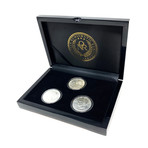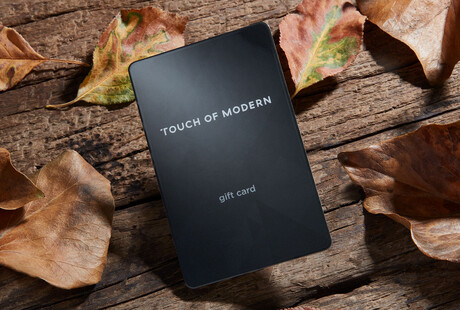Olevian Numismatic Rarities
Vintage American Silver Dollar Coin Collection // Mint State Condition // American Classics Series // Wood Presentation Box
Product Description
This collection features all three silver dollars issued by the United States during the 100-year period from 1878 to 1978, including the Morgan, Peace, and Eisenhower silver dollars. The Morgan dollar was issued from 1878 to 1904 and again in 1921. During that same year, it was replaced by the Peace dollar, which was produced until 1935. The Peace dollar was the last true silver dollar ever minted for ordinary circulation, and no dollar coins were minted again until the Eisenhower dollar debuted in 1971. The Eisenhower was produced using a copper-nickel alloy for circulation, but a select few were struck in 40% silver exclusively for collectors, which is the specimen included in this set. Today, these coins are seldom seen but are cherished by coin collectors and enthusiasts of American history alike. Offered here are three pleasant, mint-state silver dollars hand-selected by professional numismatists after screening thousands of coins for quality and eye-appeal. Each coin is housed in an airtight capsule and the set is presented in a luxurious, plush-lined wood box with embossed metallic gold lettering, piano-black finish, and certificate of authenticity. The coins are unconditionally guaranteed to be genuine, dated between 1878 and 1974, and will match the exceptional mint-state quality of the ones shown.
Named after the designer, U.S. Mint Assistant Engraver George T. Morgan, this coin was produced from 1878 to 1904 and again in 1921. The obverse of the coin depicts Liberty as a youthful woman wearing a Phrygian cap, originally worn by emancipated slaves of ancient Rome, together with a headdress of cotton and wheat— staples of the U.S. economy. The reverse features an American bald eagle with outstretched wings, symbolic of the power of the U.S. government. The eagle bears in its great talons both an olive branch and 3 arrows, representing a nation of peace but one that is poised for war. The dollar was authorized by the passage of the Bland-Allison Act in 1878, which required the Treasury to purchase an enormous 2 to 4 million dollars’ worth of silver each month to be coined into dollars. Later, in 1918, passage of the Pittman Act ultimately led to the melting of over 270 million Morgan dollars held in treasury reserves. Today, the choice few that remain are cherished specimens of a bygone era that serve to immortalize the memory of a young, prosperous, and powerful United States of America.
The Peace dollar is often considered the most beautiful silver dollar ever minted by the United States. Following World War I, there was widespread sentiment to issue a coin to commemorate the restoration of peace. At the same time, the U.S. Mint was required by the Pittman Act of 1918 to replace over 270 million silver dollars that had been melted. The federal Commission of Fine Arts held a competition and invited nine medalists to submit designs for the new dollar, including famed artists Victor D. Brenner, Herman A. MacNeil, and Adolph A. Weinman, who had already designed other circulating coins. The relatively inexperienced winner, however, was Anthony de Francisci—an Italian immigrant who modeled a depiction of Liberty after his young wife Teresa. On this stunning coin, Liberty wears a radiant crown like that worn by the Statue of Liberty, symbolizing the powers associated with the sun. The reverse features a resting eagle clutching an olive branch of peace and looking towards the sun’s rays. The word PEACE appears on a rock below the eagle, making the Peace dollar the only circulating coin in U.S. history to ever to bear that motto. Production continued until the requirements of the Pittman Act were satisfied in 1928. No dollars were minted from 1929-1933, as demand was low during the Great Depression. Limited production resumed in 1934 and 1935 for the redemption of paper silver certificates. The Peace dollar turned out to be the last true silver dollar ever minted for circulation in the United States. Sadly, its timely end came not 4 years before World War II and the end of world peace.
The Eisenhower dollar was produced from 1971 to 1978 and was the first dollar coin issued by the U.S. Mint since the Peace dollar series ended in 1935. In October of 1969, Congressman Bob Casey of Texas introduced a bill calling for a circulating commemorative dollar to honor both President Eisenhower, who had recently died, and the Apollo XI space flight, mankind’s first moon landing. Due to rising bullion prices, silver had been eliminated from the dime and quarter in 1965, and reduced to 40% in the half dollar, with plans to remove silver entirely from circulating coins in 1971. It was decided that the Eisenhower dollar would be struck in both copper-nickel for circulation and 40% silver as a collectible, to be sold at a premium. The design of Chief Engraver Frank Gasparro features a bare-headed, left-facing profile of the late president on the obverse. The reverse depicts the American eagle descending onto the moon clutching an olive branch of peace in its talons. The distant Earth is visible in the sky above. For the nation’s bicentennial in 1976, a special reverse depicting the Liberty Bell superimposed on the moon, linking the past and the present, was issued. All coins featured the dual date of 1776-1976. Although the silver pieces sold well and were coveted by collectors, the new copper-nickel dollars failed to circulate extensively, and the series was short lived. By 1978, demand for the large, clunky dollar coins diminished, and Congress replaced the Eisenhower dollar with the smaller-sized Susan B. Anthony dollar in 1979, which also failed to circulate. The Eisenhower dollar would ultimately go down in history as the last large-sized dollar coin issued for circulation in the United States, marking the end of a two century-old tradition.
Product Details
- Measurements
8"L x 6"W x 2"H
- OriginUnited States
Coin 1:
— Type: Morgan Dollar (1878-1904, 1921)
— Designer: George T. Morgan
— Weight: 26.73 grams
— Diameter: 38.1 mm
— Composition: 0.900 silver and 0.100 copper
— Net silver weight: 0.77344 oz pure silver
— Obverse Design: Liberty with Phrygian Cap and headdress of cotton and wheat / 13 stars
— Obverse Inscription: E PLURIBUS UNUM / LIBERTY / DATE
— Reverse Design: Eagle with outstretched wings, bearing an olive branch and arrows in talons / Wreath
— Reverse Inscription: UNITED STATES OF AMERICA / IN GOD WE TRUST / ONE DOLLAR
Coin 2:
— Type: Peace Dollar (1921-1935)
— Designer: Anthony de Francisci
— Weight: 26.73 grams
— Diameter: 38.1 mm
— Composition: 0.900 silver, 0.100 copper
— Net silver weight: 0.77344 oz pure silver
— Obverse Design: Liberty with radiant crown
— Obverse Inscription: LIBERTY / IN GOD WE TRVST / DATE
— Reverse Design: Eagle perched on rock with olive branch in talons / Sun rays
— Reverse Inscription: UNITED STATES OF AMERICA / E PLURIBUS UNUM / PEACE / ONE DOLLAR
Coin 3:
— Type: Eisenhower Dollar (1971-1978)
— Variety: Silver Clad (1971-1974)
— Designer: Frank Gasparro
— Weight: 24.60 grams
— Diameter: 38.50 mm
— Composition: 0.800 silver, 0.200 copper (outer layer) / 0.790 copper, 0.210 silver (inner layer)
— Net silver weight: 0.3161 oz pure silver
— Obverse Design: Dwight D. Eisenhower, facing left
— Obverse Inscription: IN GOD WE TRUST / LIBERTY / DATE
— Reverse Design: American eagle descending upon the moon, clutching an olive branch
— Reverse Inscription: UNITED STATES OF AMERICA / ONE DOLLAR
Please Note: The item(s) you receive will match the quality of the one shown, but may vary slightly due to the nature of original historical artifacts.
FAQ
Thank you for your interest. The Morgan dollars included in this set will be mint state condition, common date examples, mostly from the 1880s and 1890s, from Philadelphia, New Orleans, or San Francisco.
Shipping Information
-
Shipping AvailabilityCanada, United States
-
Shipping PolicyStandard Ground Shipping
-
Ship In2-3 weeks ⓘ
-
Return PolicyFinal sale, not eligible for return or cancellation




















































